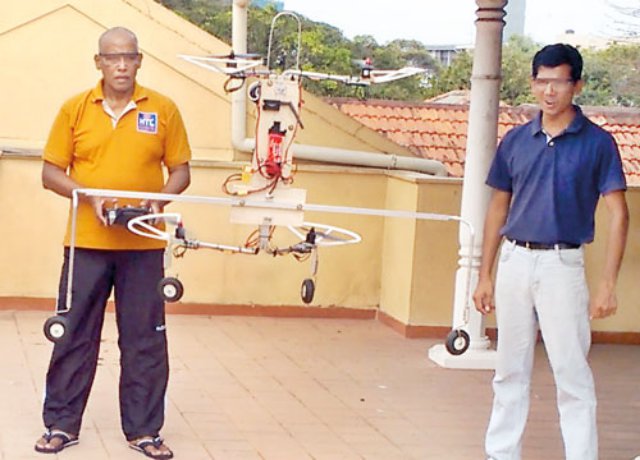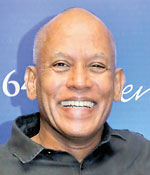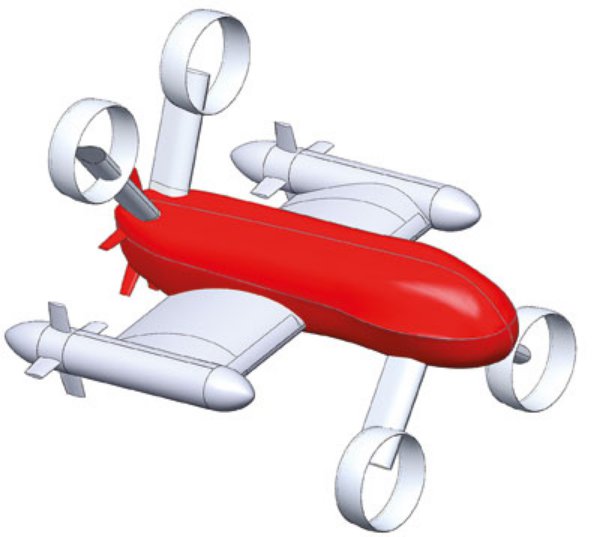Sri Lanka is no stranger to building drones – just ask the folks at the University of Moratuwa who have built surveillance drones. Now a two-story house at Amarasekera Mawatha in the middle of Havelock Town will be a place to mark, for it belongs to Tilak Dissanayake and his team of three that have a solution of fast-paced delivery drones.
Clad in an orange coloured sarong, he insists we call him Tilak as he’s not that old! The Business Times Team is advised to not remove their shoes when some of us resorted to do that after seeing a line of shoes near the staircase. “Because you might step on some sharp aluminium scraps,” Tilak warns.
Upstairs on the second floor is his living room, dining room and workshop all rolled into one, he acknowledges. As I enter the space something falls down and a young man in shorts hastens to pick it. Apparently my oversized handbag had knocked down a precariously positioned drill on a small table at the small space which incidentally houses six tables.
After apologies and ‘no … that happens often’, I am directed to a rather comfortable ergonomically designed chair and he takes the one opposite. When it comes to designing aircraft, Tilak brings a wealth of experience to the table.
This is how
An airplane enthusiast from childhood, Ray Wijewardena, aviation pioneer, the inventor of the hand tractor, the ‘Father of Dendro Power’, the architect of SALT (Sloping Agricultural Land Terracing) to name a few, was his hero.
After finishing his schooling at Royal College, Tilak attended the University of Hawaii – by sheer luck – as he calls it, where he obtained degrees in Mechanical Engineering and joined the Boeing 767 programme in Seattle in 1978 working in the propulsion technology systems group.
After about 12 years there, he moved to Xerox where he worked for seven years. Tilak then moved to Silicon Valley at the start of the Internet boom in 1996, and worked at various startup companies including Netscape for some 4-years (where he had witnessed the bust as well).
Inspiration
After 30 years in the US, Tilak returned to Sri Lanka in 2001 to look after his dad. After many ‘disastrous projects’ that ate up his savings, the inspiration for the current start-up came at Ray Wijewardene passing away. “He was my hero and as an homage to him, I wanted to combine his love for agriculture and aviation. So at the end point, it’ll pick up produce from a farm and land it near a market type of thing,” he smiles.
Now Tilak and his team’s mission is very different in that; they are the only ones doing this, he assures. Given that the end point vision has “too many moving parts”, Tilak and his team intend to initially build an air cargo network for “middle mile” courier package transport, complete with airports, segregated airways, air traffic management and airlines that use low-cost drones that can carry 20 kg initially at speeds of 200 kmph.
In October 2016, Akshayan Rajasingam (physics major with an MSc specialised in simulation development) – he’s the chap who picked up the drill off the floor – joined the team and Mevan Pathberiya (an aeronautical engineer) joined soon after. Late last year, Kavindi De Silva (3 years in astronomy) joined the team. “They all currently work for peanuts,” Tilak says because they believe in this product and know it will get funded.
With this technically robust team in place, Tilak now had the start-up he always wanted. “I am using my pension funds for this project,” he says laughing. He began in 2013 to work full-time on the Robotic Air Cargo Network (RACN) using his pension from Xerox and Boeing. He estimates that it will take US$ 50 million to $100 million to design, test and certify the airplane and other parts of the RACN over 3-4 years.
Currently, there are operations that use drones to deliver goods. DHL pioneered commercial delivery with a 1 kg package to an island 12 km off the German coast almost three years ago. The more recent example is Zipline which delivers 150+ blood packs per day to 21 hospitals in Rwanda. Dubai just announced that they will have a one-person air taxi service by July this year. So Sri Lanka can be next in line. When the funds come in, that is.
Almost all (the authorities, courier companies, et al) are interested in his product, Tilak says. “But the local business community will never fund this,” he says adding that this is because ‘they’ll never understand it, and would rather build another hotel or casino’. The main funding will be to pay the engineering team and for simulation software and equipment to get them through the design, concept demonstration and certification flight testing phases.
There is also a Chinese and an Australian party that are potentially interested in this. Tilak is only fond of venture capitalists (VC) who don’t want to go public. “Engineering firms should never be publicly traded,” he says, and he actually prefers debt funding. The Government has allocated a small amount of funding in 2017 as the first step to setting up a long-term loan facility to potentially lend money to the kinds of projects like the RACN which can have a huge impact on the economy and drive high tech exports dramatically.
As most Sri Lankans are skeptical without a prototype, so they built some. He shows apparatuses that seem like lopsided drum sets (apparently that’s their latest Mark 3 drone costing some Rs. 350,000) and goes to a larger cupboard near the door to the balcony pointing out the International Civil Aviation Organization (ICAO) regulations – about 700-80 neatly bound books. “The Sri Lanka Civil Aviation Authority’s role is that of a certification authority to ensure that the robotic air cargo network is in compliance with all ICAO rules and regulations,” he says noting that they are eager to see this project get funded and underway.
His drones can lift 20kg at once, he says and saunters to a desk to retrieve a rectangular box. “This where all the packages go in,” he says opening the box to reveal all sorts of empty boxes from named couriers. Robotic cargo drones will grow into an even larger industry in the coming years, simply because, unencumbered by the weight of human pilots and their life-support systems, they will fly more cheaply but be just as fast and safe, he adds.
Meanwhile noticing a yellow R2D2 (fictional robot character in the Star Wars franchise), I ask whether it’s a vacuum. To the mirth of all they laugh and say it is indeed a vacuum cleaner.
Saving lives
Tilak and his team envision an RACN that can be used for middle mile transport which is when couriers transport goods from one hub to another. Cargo drone networks can save lives in addition to driving the economy and creating jobs, he says citing the Rwandan example.
Tilak and team’s goal is to create a low cost air cargo transportation network which has low cost VTOL (Vertical Take Off and Landing) airplanes (which only need a 5m diameter pad to operate from) with narrow, segregated “middle mile” airways, low cost automated air traffic management system and low cost small airfields. Since the airplane itself is smart and does not need a pilot, the airline will also be low cost. “We already identified about 40 airports based on the current towns that local couriers serve.”
So he wants to create a product design engineering (PDE) firm and obtain a type certificate for the airplane, which in Essence is like an international patent. Then these flying bots can be licensed to various manufacturers around the world for production in exchange for royalties. Tilak estimates there will be a world-wide demand for about 2-4 million of the low-cost ($20,000) airplanes. The battery and spare part royalties along with transaction based revenue from the cargo handling and air traffic management system will result in a highly profitable PDE firm in return for the $50-100 million investment.
“Government and industry leadership doesn’t understand product design engineering,” he says noting that Sri Lanka has very few PDE companies and thus has a dismal economy here and low high-tech exports. There’s only Lanka Transformers, Orange Electric, Neil Marine, Jinasena, etc as PDE firms,” he says making his point. He shows a Forbes list of PDE companies such as Volkswagen, Honda, Boeing, etc emphasizing that economies are driven by PDE companies and not technology R&D centres. However, he is quick to point out that, “us engineers need the output of basic and applied research to create the worlds that have never been, but Sri Lanka’s priority need of the hour is investment in PDE since the world has an amazing set of materials, components and processes like at no other time with which to design products.”
He says: “There’s no sensible funding source for PDE companies to drive the economy as banks are too ‘conservative’ (short tenure, collateral based lending) to lend, the big company leadership is risk averse and would rather build another hotel/condo/casino and VC funding too impatient and inappropriate for engineering companies in most cases.”
There are many experienced engineers with great product ideas to drive the economy, but there’s brain drain (and loss of potential tax revenue) due to lack of job opportunities, he says noting that as a result there’s no ROI on education investment. “There’re many companies willing to invest in manufacturing of certified products but what we need is for a Long-Term Loan Facility (LTLF) to fund Product Design Engineering (PDE) companies,” he stresses.
When we are about to leave, I ask him if he could build me a futuristic oven so that I don’t have to fuss over it while it cooking my dinner; turns out he can. That’s because he is the son of a famous local culinary expert, Chandra Dissanayake. “It won’t be too difficult because I grew up in a culinary school,” he says with a smile.
Source: The Sunday Times



